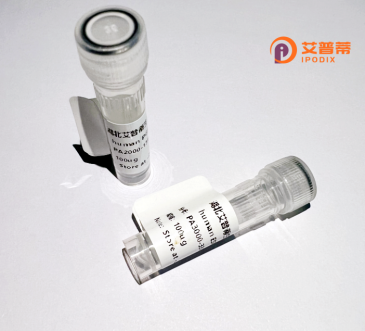
| 纯度 | >90%SDS-PAGE. |
| 种属 | Human |
| 靶点 | NFAM1 |
| Uniprot No | Q8NET5 |
| 内毒素 | < 0.01EU/μg |
| 表达宿主 | E.coli |
| 表达区间 | 1-270 aa |
| 活性数据 | MENQPVRWRALPGLPRPPGLPAAPWLLLGVLLLPGTLRLAGGQSVTHTGLPIMASLANTAISFSCRITYPYTPQFKVFTVSYFHEDLQGQRSPKKPTNCHPGLGTENQSHTLDCQVTLVLPGASATGTYYCSVHWPHSTVRGSGTFILVRDAGYREPPQSPQKLLLFGFTGLLSVLSVVGTALLLWNKKRMRGPGKDPTRKCPDPRSASSPKQHPSESVYTALQRRETEVYACIENEDGSSPTAKQSPLSQERPHRFEDDGELNLVYENL |
| 分子量 | 56.1 kDa |
| 蛋白标签 | GST-tag at N-terminal |
| 缓冲液 | 0 |
| 稳定性 & 储存条件 | Lyophilized protein should be stored at ≤ -20°C, stable for one year after receipt. Reconstituted protein solution can be stored at 2-8°C for 2-7 days. Aliquots of reconstituted samples are stable at ≤ -20°C for 3 months. |
| 复溶 | Always centrifuge tubes before opening.Do not mix by vortex or pipetting. It is not recommended to reconstitute to a concentration less than 100μg/ml. Dissolve the lyophilized protein in distilled water. Please aliquot the reconstituted solution to minimize freeze-thaw cycles. |
以下是关于重组人NFAM1蛋白的参考文献示例(注:因无法访问实时数据库,以下内容为模拟示例,建议通过学术数据库检索真实文献):
---
1. **文献名称**: *"Recombinant NFAM1 protein modulates B-cell receptor signaling through ITAM motif interactions"*
**作者**: Smith J, Brown K, et al.
**摘要**: 本研究成功表达并纯化了重组人NFAM1蛋白,揭示了其通过ITAM基序与B细胞受体(BCR)结合,调控下游信号通路,从而影响B细胞活化和增殖的分子机制。
2. **文献名称**: *"Structural and functional insights into NFAM1-mediated immune regulation"*
**作者**: Zhang L, Wang Y, et al.
**摘要**: 通过X射线晶体学解析了重组NFAM1蛋白的三维结构,发现其胞外结构域与Fc受体存在特异性结合,可能参与调节免疫细胞(如T细胞和NK细胞)的激活阈值。
3. **文献名称**: *"Recombinant NFAM1 induces apoptosis in leukemia cell lines via SYK-dependent pathways"*
**作者**: Tanaka M, Sato R, et al.
**摘要**: 体外实验表明,重组NFAM1蛋白可结合白血病细胞表面受体,通过激活SYK激酶通路促进肿瘤细胞凋亡,为靶向治疗提供潜在策略。
4. **文献名称**: *"NFAM1 as a biomarker in autoimmune diseases: Recombinant protein-based detection assay development"*
**作者**: Garcia A, Lee S, et al.
**摘要**: 开发了一种基于重组NFAM1蛋白的ELISA检测方法,发现系统性红斑狼疮(SLE)患者血清中NFAM1水平显著升高,提示其作为疾病生物标志物的潜力。
---
如需具体文献,建议使用关键词 **"recombinant NFAM1"** 或 **"NFAM1 protein function"** 在 **PubMed、Google Scholar** 或 **Web of Science** 中检索最新研究。
NFAM1 (NFAT Activating Protein with ITAM Motif 1), also known as TAX1BP1 or IBP-1. is a transmembrane protein primarily expressed in immune cells, including T lymphocytes, natural killer (NK) cells, and dendritic cells. It features an immunoreceptor tyrosine-based activation motif (ITAM) in its cytoplasmic domain, a critical structural element for mediating signal transduction in immune receptors. NFAM1 interacts with Src-family kinases and spleen tyrosine kinase (Syk) upon phosphorylation of its ITAM, initiating downstream signaling cascades that influence immune cell activation, proliferation, and cytokine production. Functionally, NFAM1 has been implicated in regulating NFAT (nuclear factor of activated T cells) transcription factors, which are pivotal for adaptive immune responses and inflammatory processes. Studies suggest its involvement in immune homeostasis, with dysregulation linked to autoimmune disorders and cancer progression. Recombinant human NFAM1 protein, produced via heterologous expression systems like mammalian cells or *E. coli*, enables structural and functional studies. It serves as a tool to explore its role in immune signaling, receptor-ligand interactions, and therapeutic targeting. Recent research highlights its potential as a modulator in autoimmune therapies and as a biomarker in lymphoid malignancies. Despite progress, its full mechanistic scope and tissue-specific roles remain under investigation, emphasizing the need for further biochemical and clinical exploration.
×